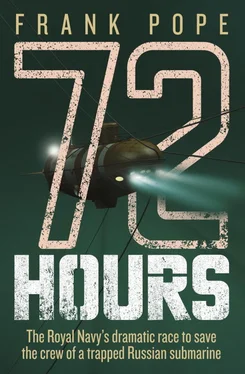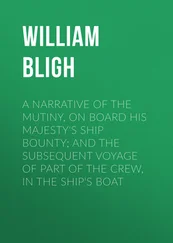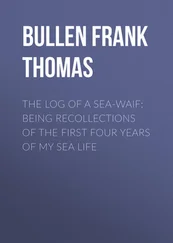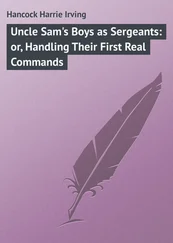They filed in, finding places to sit on disintegrating chairs. Beneath the harsh lights of the cabin, Podkapayev looked haggard; his shoulders rigid, his eyes dull and tired. Despite Russia’s enormous geography, the members of the Priz fleet of rescue submersibles were relatively few and he’d trained with three of the trapped men from time to time. He didn’t know the younger sailors, but he was worried for them too – they were little older than his own son. More than anyone he was concerned about his good friend Gennady Vasiliyevich Bolonin. He’d spent many long evenings with the civilian engineer, the esteemed co-designer of the Priz class, back in Nizhny Novgorod. And Podkapayev knew that though Bolonin’s mind was bright, his 60-year-old body was not as robust as it once had been. How would he be dealing with the freezing temperatures, his lungs heaving ever harder to feed from the thinning air?
Podkapayev began talking in bursts, waiting with barely restrained impatience for Captain Holloway to translate before continuing.
‘I’m not sure what reports you’ve heard, so I’ll start from the beginning,’ he said. ‘The AS-28 is stuck at 210 metres, trapped in cables. The depth of water is about 230 metres. The accident happened when they were inspecting an underwater antenna. We have seven men on board, and their air is already very limited. They have been down there since Thursday – almost three days. At our most optimistic estimates, they have between twenty and twenty-four hours of life remaining. I have reports from the bathyscaphe’s commander, as well as some photos and video taken with our Tiger ROV.’
In the cramped and salt-sticky cabin Podkapayev pulled out a modern, state-of-the-art laptop from his bag. He fed it a DVD. The grainy pictures showed swirling sediment, and each of the team strained forward to see what was there. A white band moved across the screen. At first they thought it was interference on the camera, but Podkapayev jabbed at it with his finger. Sure enough, in a few moments it resolved into the striped paintwork of the submarine’s hull.
The picture got no better. For 15 minutes the British rescuers peered into the jumping, distorted images. Any clues they could glean from the recording would give them a head start and maybe even prompt them to make adjustments to Scorpio before she went down. But for all their eagerness to make sense of it, they couldn’t see enough to draw any firm conclusions about how the vessel was trapped.
‘Can you explain to us what’s going on? Maybe you got a better idea while watching it live,’ Gold said, and Holloway relayed the question.
Podkapayev nodded. From a file he pulled out a simple line drawing showing two long tubes – the floatation tanks – and up at the far end of the upper one, the submersible with a cluster of lines wrapped around the fin. From the picture it looked as though the craft could just reverse to free itself, so something was obviously missing. Various dimensions were scrawled on the drawing, the numerals jumping out from the Cyrillic characters. The tubes were huge – 102 metres long. They floated 8.5 metres above the bottom on chains anchored to large concrete blocks on the seabed. AS-28 was ensnared towards the top of the array some 25 metres above the seabed. That meant working mid-water, without the ability to stabilise Scorpio by resting her skids on the seabed.
Seeing the diagram, Gold brightened. It was a clear representation of the situation at last, even if it was incomplete. He began asking questions, starting with what the lines were made of. This was of vital importance. Scorpio could cut wire cable up to 20mm with ease, but they had also brought LR5’s cutter, which could be fitted to Scorpio. It was more unwieldy, but it could cut up to 70mm. So far all he’d heard was that none of the lines were larger than 18 mm, but nothing could be taken for granted. All Podkapayev could do was shrug.
‘We’ve tried to estimate from the pictures. I can only show you what I saw,’ he said. He turned back to his laptop and pulled up some colour images. Their quality was better than the video, but despite lots of discussion and theorising no one could say for sure what the lines were made of. If they were rope then that was one thing, if they were wire it was quite another.
‘Okay,’ said Gold. ‘We’ve got a picture of how things look down there now. Now we need to work out how things are going to look up top. Since this ship does not have Dynamic Positioning, what kind of an anchor web are you thinking of?’
Gold was long in the tooth enough to have worked off ships and platforms that had no DP and were held in place by an altogether more rudimentary system: anchors. With one – or sometimes two – stretching from each corner on long cables, a work barge could be accurately positioned by reeling in or slackening off the cables. It was slow, cumbersome and affected by changing tides, but at least it was safe; trying to operate an ROV from an unsecured vessel without Dynamic Positioning was a sure way to lose the vehicle. Currents and wind would push the ship around, tugging at the umbilical. Sooner or later the ROV would hit something or get tangled up with something on the seabed. If the ship was being carried away the all-important umbilical might be stretched, kinked or snapped. But pay out too much slack to try to avoid this and you risked a loose loop of umbilical drifting into the path of the ship’s propellers, which would be equally disastrous.
Holloway relayed the question.
‘The water there is too deep for KIL-27 to anchor. We don’t have enough cable,’ Podkapayev replied.
Gold looked over at Riches, alarmed. Podkapayev caught his expression and began explaining in fast Russian, taking a salt shaker from the table and motioning with his hands across the cracked lino table. Seeing blank looks on their faces, he called out of the corridor and a minute later a sailor appeared with a whiteboard and a marker.
He drew a triangle to represent KIL-27 , then two other triangles at either end. ‘These are ships that are able to be moored on site. They have enough anchor cable. They will be positioned at either end of the hydrophone array. When we arrive, we will attach lines to them from our bow and stern, and they will hold us in position.’
Gold was staring at the whiteboard, his eyes flicking between various parts of Podkapayev’s diagram. He was calculating the stresses and strains, testing the idea in his head, trying to work out how the complicated set-up would react to different winds, currents and swells. He’d never heard of anyone using such a system, and neither had the others. Podkapayev was adamant that it would work, but if it didn’t Scorpio could end up being lost – together with the men they were there to rescue.
‘I’m not sure it can be done. There’s any number of things that could go wrong with it,’ said Gold. He knew only too well that, given time, the sea would find the weakness in their system as surely as it would find cracks in a hull. ‘But it sounds like it’s our only option. All we can do is give it a try.’
Much would depend on the weather. Remembering his assurances to the USN Commander, Kent Van Horn, about the condition of the elements, Riches asked Podkapayev what the latest forecast was.
Podkapayev nodded. ‘For the moment it is good – calm and with only small waves. But there is a front coming in from the southeast. We don’t know when it will hit.’ With that he looked around the table at each of the three men. The question in his eyes was unmistakeable. This would be the main problem then. Without heavy winds or swells pushing them around they had a good chance of remaining securely moored between the two ships. But if conditions worsened then the complex chain of connections between the anchors and their vessel could amplify the movements, giving them real trouble. They’d have to be on their toes; if the weather came in fast from the wrong direction, Scorpio could end up getting trapped with its umbilical acting as a further noose around AS-28 and the men inside it.
Читать дальше












